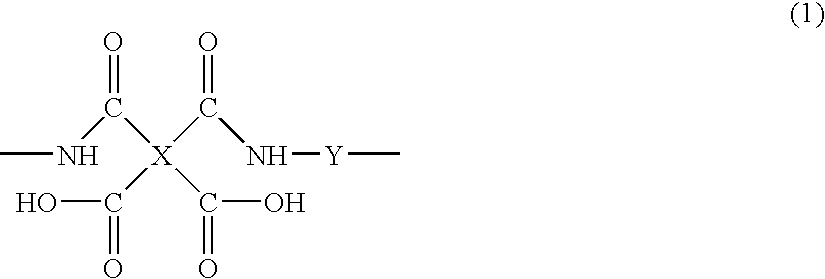Halogenated polyamide acid composition and its applications
a technology of halogenated polyimide and acid composition, which is applied in the direction of instruments, optical elements, optics, etc., can solve the problems of not being described as useful for optical materials, large scale apparatus and complicated production steps, and inability to control the refractive index of halogenated polyimide, so as to achieve simple control of the refractive index and improve the effect of pressure reduction
- Summary
- Abstract
- Description
- Claims
- Application Information
AI Technical Summary
Benefits of technology
Problems solved by technology
Method used
Image
Examples
synthesis example 1
[0114]A 50-mL three-necked flask was charged with 1.80 g (10 mmol) of 1,3-diamino-2,4,5,6-tetrafluorobenzene, 5.82 g (10 mmol) of 4,4′-[(2,3,5,6-tetrafluoro-1,4-phenylene)bis(oxy)]bis(3,5,6-trifluorophthalic anhydride) of formula 9:
[0115]
and 12.4 g of N,N-dimethylacetoamide. The mixture was stirred at room temperature in a nitrogen atmosphere for 6 days to give a halogenated polyamide acid solution (solid content: 38.0% by mass).
synthesis example 2
[0116]A 50-mL three-necked flask was charged with 1.97 g (10 mmol) of 5-chloro-1,3-diamino-2,4,6-trifluorobenzene, 5.82 g (10 mmol) of 4,4′-[(2,3,5,6-tetrafluoro-1,4-phenylene)bis(oxy)]-bis(3,5,6-trifluorophthalic anhydride) used in Synthesis Example 1, and 15.8 g of N,N-dimethylacetoamide. The mixture was stirred at room temperature in a nitrogen atmosphere for 6 days to give a halogenated polyamide acid solution (solid content: 33.0% by mass).
synthesis example 3
[0117]A 50-mL three-necked flask was charged with 1.97 g (10 mmol) of 5-chloro-1,3-diamino-2,4,6-trifluorobenzene, 5.82 g (10 mmol) of 4,4′-[(2,3,5,6-tetrafluoro-1,4-phenylene)bis(oxy)]-bis(3,5,6-trifluorophthalic anhydride) used in Synthesis Example 1, and 10.75 g of N,N-dimethylacetoamide. The mixture was stirred at room temperature in a nitrogen atmosphere for 6 days to give a halogenated polyamide acid solution (solid content: 42.0% by mass). To the halogenated polyamide acid solution, bis(pentafluorophenyl)sulfide was added so as to become 25% by mass of total sold content (accordingly, the halogenated polyamide acid is 75% by mass of total solid content), and the mixture was stirred and defoamed using a self / centrifugal double rotation mixer (trade name: “AWATORI RENTARO”, available form Thinky Corporation) to give a halogenated polyamide acid composition for the core layer.
[0118]Then, production examples of halogenated polyimide films (hereinafter referred to simply as the “p...
PUM
| Property | Measurement | Unit |
|---|---|---|
| refractive index | aaaaa | aaaaa |
| refractive index | aaaaa | aaaaa |
| transparency | aaaaa | aaaaa |
Abstract
Description
Claims
Application Information
 Login to View More
Login to View More - R&D
- Intellectual Property
- Life Sciences
- Materials
- Tech Scout
- Unparalleled Data Quality
- Higher Quality Content
- 60% Fewer Hallucinations
Browse by: Latest US Patents, China's latest patents, Technical Efficacy Thesaurus, Application Domain, Technology Topic, Popular Technical Reports.
© 2025 PatSnap. All rights reserved.Legal|Privacy policy|Modern Slavery Act Transparency Statement|Sitemap|About US| Contact US: help@patsnap.com



